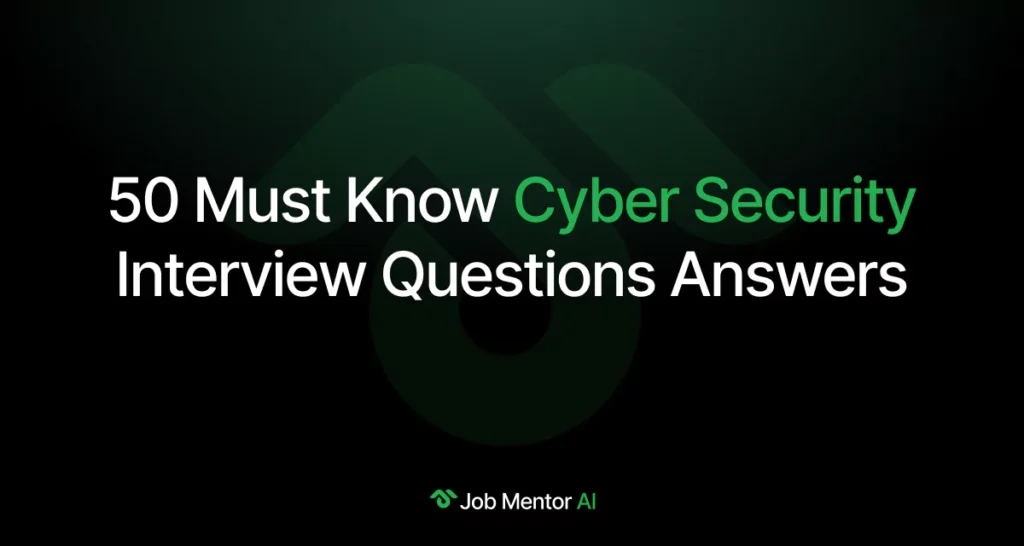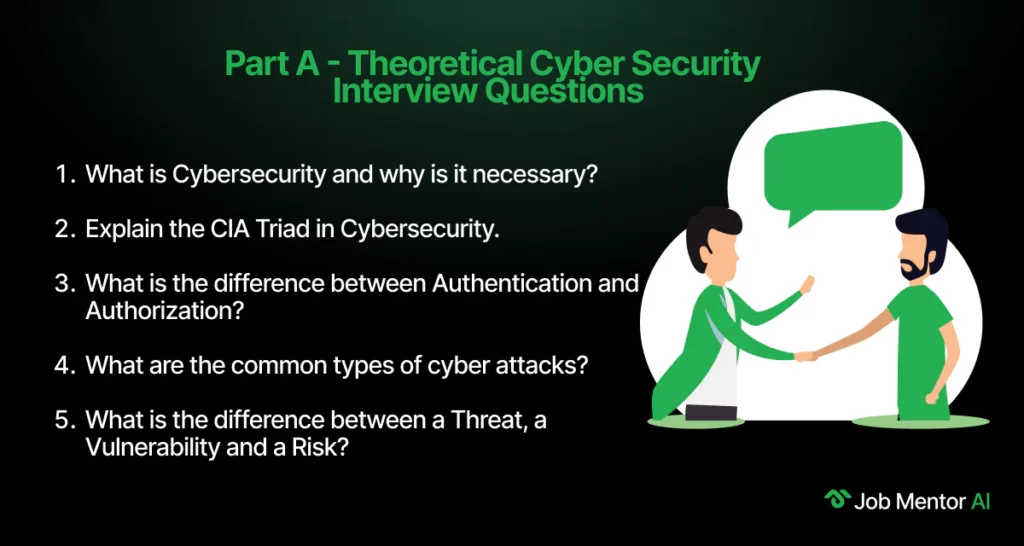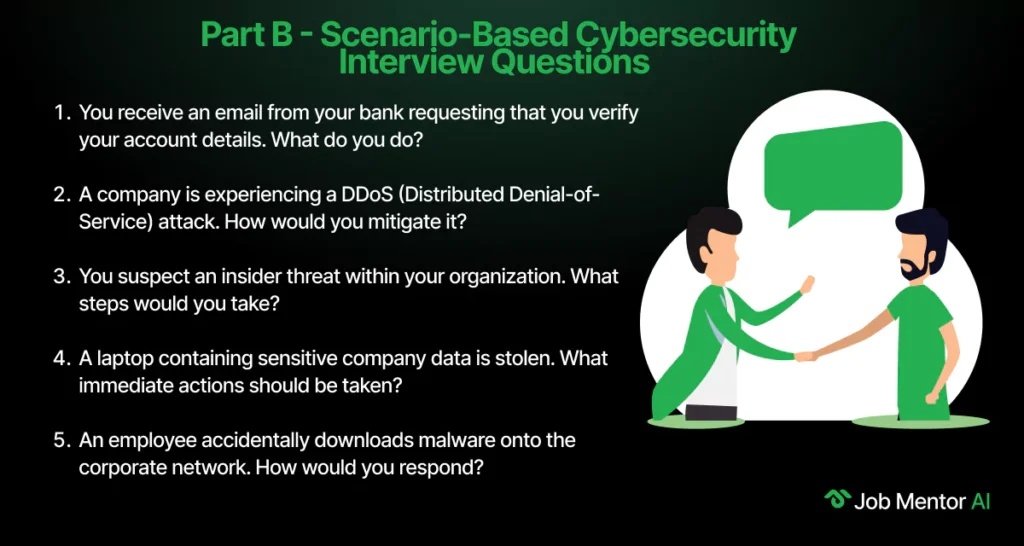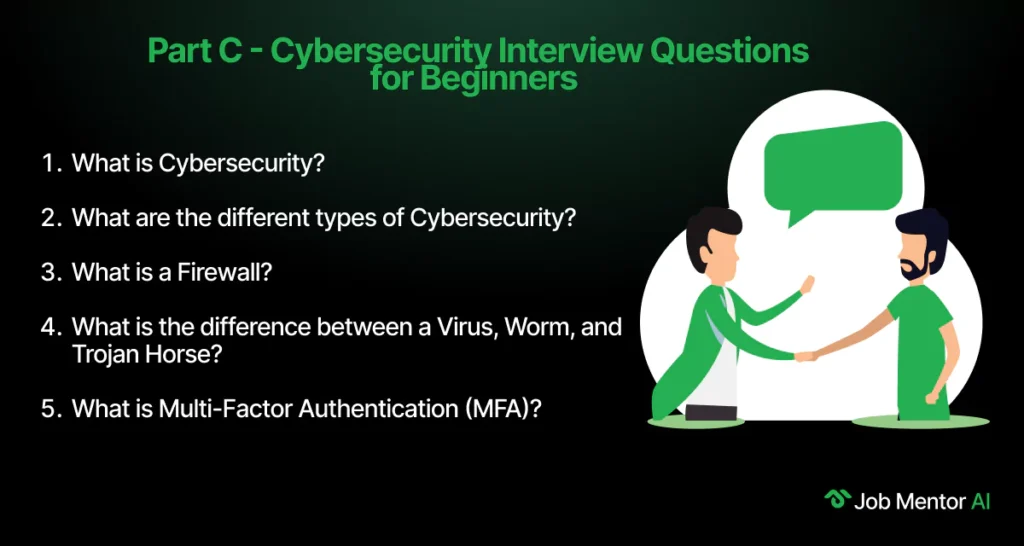50 Must Know Cyber Security Interview Questions Answers
Cybersecurity is an ever-evolving field that plays a crucial role in protecting sensitive information and ensuring digital safety. Whether you’re an aspiring cybersecurity professional or an experienced expert looking to sharpen your skills, preparing for interviews is essential. This guide covers theoretical, scenario-based and skill-level-specific cybersecurity interview questions, helping you build confidence for your next interview.

Part A – Theoretical Cyber Security Interview Questions
1. What is Cybersecurity and why is it necessary?
2. Explain the CIA Triad in Cybersecurity.
3. What is the difference between Authentication and Authorization?
4. What are the common types of cyber attacks?
5. What is the difference between a Threat, a Vulnerability and a Risk?
Part B – Scenario-Based Cybersecurity Interview Questions
1. You receive an email from your bank requesting that you verify your account details. What do you do?
2. A company is experiencing a DDoS (Distributed Denial-of-Service) attack. How would you mitigate it?
3. You suspect an insider threat within your organization. What steps would you take?
4. A laptop containing sensitive company data is stolen. What immediate actions should be taken?
5. An employee accidentally downloads malware onto the corporate network. How would you respond?
Part C – Cybersecurity Interview Questions for Beginners
1. What is Cybersecurity?
2. What are the different types of Cybersecurity?
3. What is a Firewall?
4. What is the difference between a Virus, Worm, and Trojan Horse?
5. What is Multi-Factor Authentication (MFA)?
Part D: Cybersecurity Interview Questions for Intermediate-Level
1. What is an SQL Injection attack and how can you prevent it?
2. What is the difference between Symmetric and Asymmetric Encryption?
3. Explain the concept of a Man-in-the-Middle (MITM) attack.
4. What is the difference between IDS and IPS?
5. What is a DDoS attack and how can it be mitigated?
6. What is the purpose of network segmentation?
7. What is a Zero-Day Exploit?
Part E: Cybersecurity Interview Questions for Advanced Level
1. Explain the concept of Defense in Depth.
2. What is a threat-hunting approach in Cybersecurity?
3. What is a Public Key Infrastructure (PKI) and how does it work?
4. What is the role of an Ethical Hacker?
5. What are Advanced Persistent Threats (APTs)?
Part A - Theoretical Cyber Security Interview Questions
In any cybersecurity interview, you expect to begin with questions that test your understanding of the fundamental concepts of cybersecurity. These cybersecurity interview questions and answers focus on critical definitions, technical terms, and key distinctions demonstrating your grasp of the field.

1. What is Cybersecurity and why is it necessary?
Cybersecurity is the process of safeguarding networks, systems and data from cyberattacks in cyberspace. The significance of Cybersecurity is to ensure data integrity, confidentiality and availability and prevent unauthorized use and cyberattacks.
2. Explain the CIA Triad in Cybersecurity.
The CIA Triad represents the principles of Confidentiality, Integrity and Availability.
- Confidentiality renders the information accessible to authorized persons only.
- Integrity ensures that information is accurate and unaltered.
- Availability ensures the availability of data when needed.
3. What is the difference between Authentication and Authorization?
Authentication confirms the identity of an individual, while authorization establishes the degree of access a validated user has to a resource or system.
4. What are the common types of cyber attacks?
Cyber attacks include:
- Phishing (fraudulent efforts to get sensitive information)
- Ransomware (data-encrypting malware that asks for ransom)
- Denial-of-Service (DoS) (overloading the networks to render them unavailable)
- Man-in-the-middle (MitM) (intercepting communications between two parties)
- SQL Injection (injecting malicious SQL code into a database query)
- Zero-Day Exploit (exploiting a software vulnerability before a fix is present)
5. What is the difference between a Threat, a Vulnerability and a Risk?
Threat: Potential threats that could exploit weaknesses (e.g., hackers, malware).
Vulnerability: A flaw in a system that can be taken advantage of (e.g., outdated software).
Risk: The likelihood of a threat exploiting a vulnerability
6. What is Multi-Factor Authentication (MFA)?
MFA is a security measure that requires users to verify their identity using multiple factors of authentication
(e.g., password + fingerprint or OTP).
7. What is the role of encryption in Cybersecurity?
Encryption converts information into an unreadable format using cryptographic algorithms so that only authorized parties can decrypt and read the data.
8. What is Social Engineering in Cybersecurity?
Social engineering is a deceptive technique employed by attackers to manipulate individuals into revealing confidential data like login details or financial data.
9. What is the Principle of Least Privilege (PoLP)?
PoLP is a security concept under which users and programs have only those rights that are necessary for them to accomplish their tasks.
10. What is Zero Trust Security?
Zero Trust Security is a model that assumes no one can trust any entity by default and must be continuously verified for all devices and users accessing resources.
Part B - Scenario-Based Cybersecurity Interview Questions
This section presents technical cybersecurity interview questions that assess how you apply your knowledge in real-world situations. You must be ready to walk through different scenarios, explain methodologies, terms, and demonstrate hands-on problem-solving skills.

1. You receive an email from your bank requesting that you verify your account details. What do you do?
This is likely a phishing attempt. You should:
- Avoid clicking any links in the email.
- Verify the sender’s email address.
- Call the bank directly using official contact information.
2. A company is experiencing a DDoS (Distributed Denial-of-Service) attack. How would you mitigate it?
Mitigation strategies involve:
- Blocking and detection of malicious IP addresses.
- Employing a Content Delivery Network (CDN) to manage traffic surges.
- Implementing a Web Application Firewall (WAF).
- Rate limiting to prevent too many requests from the same source.
3. You suspect an insider threat within your organization. What steps would you take?
Some of the steps involve:
- Track user activities and audit access logs.
- Restrict privileged access to critical systems.
- Implement security awareness training.
- Implement behavioral analytics solutions for anomaly detection.
4. A laptop containing sensitive company data is stolen. What immediate actions should be taken?
Some of the immediate actions that should be taken are:
- Report the theft to IT and security teams.
- If feasible, wipe the device or deactivate access remotely.
- Reset passwords for accounts accessed through the laptop.
- Audit all unauthorized access to company systems.
5. An employee accidentally downloads malware onto the corporate network. How would you respond?
- Quarantine the affected computer to prevent malware from spreading.
- Perform anti-virus and malware scans to remove threats.
- Identify how the malware entered and educate employees to avoid future incidents.
- Strengthen security measures to prevent recurrence.
6. Your company’s website is defaced by hackers. What would be your first steps?
- Take the website offline to prevent any further damage.
- Examine logs to see how the attackers accessed.
- Recover the website from a safe backup.
- Patch any vulnerabilities exploited by the attackers.
7. Your organization needs to comply with GDPR. What are the key security measures?
Some of the key security measures are:
- Encrypt and safeguard personal data.
- Implement strict access controls.
- Obtain user consent for data gathering.
- Run routine security scans.
8. In case of a ransomware attack, what would you do?
- Isolate infected systems to prevent spreading.
- Evaluate the level of damage.
- Recover the data if backups exist.
- Report the incident to the police.
9. How do you handle third-party security threats?
- Conduct vendor security audits.
- Maintain third-party adherence to security requirements.
- Limit third-party access to confidential data.
10. A user reports a suspicious email containing a link. What do you do?
- Alert the user not to click on the link.
- Investigate the email source.
- Alert the security team for further inspection.
- Train employees on phishing threats.
Part C - Cybersecurity Interview Questions for Beginners
Employers want cybersecurity professionals who are quick yet effective thinkers, communicate professionally, and work well under pressure. These behavioral cybersecurity interview questions and answers help you showcase your interpersonal skills, judgment, and past experiences using the STAR method (Situation, Task, Action, Result).

1. What is Cybersecurity?
Cybersecurity refers to the practice of protecting computer systems, networks, and data from cyber threats like hacking, malware, and phishing attacks. It involves various security measures, including encryption, firewalls, and multi-factor authentication.
2. What are the different types of Cybersecurity?
Cybersecurity is broadly classified into:
- Network Security – Protecting networks from cyber threats.
- Information Security – Securing data from unauthorized access.
- Application Security – Protecting software from vulnerabilities.
- Cloud Security – Ensuring security in cloud environments.
- Endpoint Security – Securing devices like laptops and mobiles.
3. What is a Firewall?
A firewall is a network security device that monitors and controls incoming and outgoing traffic based on security rules. It acts as a barrier between a trusted internal network and an untrusted external network.
4. What is the difference between a Virus, Worm, and Trojan Horse?
- Virus: Attaches to files and spreads when executed.
- Worm: Spreads automatically without human intervention.
- Trojan Horse: Disguises itself as a legitimate program but contains malicious code.
5. What is Multi-Factor Authentication (MFA)?
MFA is a security measure that requires users to verify their identity using multiple authentication factors, such as a password (something you know), a fingerprint (something you have), and a one-time code (something you receive).
6. What is Phishing?
Phishing is a cyberattack where attackers trick users into revealing personal information by pretending to be a legitimate source, usually through fake emails or websites.
7. What is the CIA Triad in Cybersecurity?
The CIA Triad consists of:
- Confidentiality – Ensuring only authorized users can access data.
- Integrity – Protecting data from unauthorized modifications.
- Availability – Ensuring data is accessible when needed.
8. What is the difference between HTTPS and HTTP?
- HTTP (Hypertext Transfer Protocol): Transfers data in plaintext, making it vulnerable to attacks.
- HTTPS (Hypertext Transfer Protocol Secure): Uses encryption (SSL/TLS) for secure data transmission.
9. What is an IP Address?
An Internet Protocol (IP) address is a unique numerical label assigned to a device connected to the Internet. It helps identify and communicate with other devices.
10. What are the common Cybersecurity Threats?
Some common threats include:
- Malware
- Phishing
- Ransomware
- Man-in-the-middle (MITM) attacks
- Denial of Service (DoS) attacks
Part D: Cybersecurity Interview Questions for Intermediate-Level
Your motivation, goals, and personal alignment with the organization’s mission matter just as much as your technical expertise. These cybersecurity interview questions help interviewers understand what drives you and whether you’ll thrive within the team.

1. What is an SQL Injection attack and how can you prevent it?
SQL Injection is a type of attack where malicious SQL code is inserted into a web application’s query to manipulate the database. It can be prevented by using parameterized queries, stored procedures, and input validation.
2. What is the difference between Symmetric and Asymmetric Encryption?
Symmetric encryption uses the same key for both encryption and decryption, while asymmetric encryption uses a pair of keys: a public key for encryption and a private key for decryption.
3. Explain the concept of a Man-in-the-Middle (MITM) attack.
An MITM attack occurs when an attacker intercepts and possibly alters the communication between two parties without their knowledge. It can be prevented by using secure communication protocols like HTTPS and SSL/TLS.
4. What is the difference between IDS and IPS?
IDS (Intrusion Detection System) monitors network traffic for suspicious activity and alerts administrators, while IPS (Intrusion Prevention System) actively blocks malicious traffic based on predefined security rules.
5. What is a DDoS attack and how can it be mitigated?
A DDoS (Distributed Denial of Service) attack involves overwhelming a target system with a large volume of traffic, making it unavailable to users. Mitigation techniques include rate-limiting, traffic filtering, and using content delivery networks (CDNs).
6. What is the purpose of network segmentation?
Network segmentation divides a network into smaller, isolated sub-networks to improve security and performance. It helps limit the spread of cyberattacks and reduces the attack surface.
7. What is a Zero-Day Exploit?
A zero-day exploit is a vulnerability in software or hardware that is unknown to the vendor or security community, meaning it has not yet been patched or fixed. Attackers exploit it before the vendor can release a fix.
8. What is a Security Information and Event Management (SIEM) system?
SIEM systems collect, aggregate and analyze log data from various sources within a network to detect, monitor and respond to security threats in real-time.
9. What is a Vulnerability Assessment and how is it different from Penetration Testing?
Vulnerability assessment involves identifying, quantifying and prioritizing vulnerabilities in a system. Penetration testing simulates an attack to identify and exploit security weaknesses to assess the system’s defenses.
10. What are some common types of malware?
Common types of malware include viruses, worms, Trojans, ransomware, spyware and adware. Each type has different methods of infection and impact on the system.
Part E: Cybersecurity Interview Questions for Advanced Level
This section addresses frequently asked questions that provide insight into the broader cybersecurity career landscape and your understanding of it. These cybersecurity interview questions and answers explore job roles, certifications, challenges, and growth opportunities.

1. Explain the concept of Defense in Depth.
Defense in Depth is a layered security strategy that uses multiple defensive measures to protect an organization’s assets. It involves implementing security at various levels, such as network, endpoint, application and physical security.
2. What is a threat-hunting approach in Cybersecurity?
Threat hunting is a proactive approach to Cybersecurity where security professionals actively search for signs of malicious activities within a network rather than waiting for automated systems to detect threats.
3. What is a Public Key Infrastructure (PKI) and how does it work?
PKI is a framework that manages digital keys and certificates. It enables secure communication by using asymmetric encryption with a public and private key pair. The PKI system includes a certificate authority (CA) that issues digital certificates for authentication.
4. What is the role of an Ethical Hacker?
An ethical hacker, also known as a white-hat hacker, is employed to test and secure systems by finding and exploiting vulnerabilities to identify weaknesses before malicious hackers can exploit them.
5. What are Advanced Persistent Threats (APTs)?
APTs are prolonged and targeted cyberattacks that aim to infiltrate and steal sensitive information over time. They are highly sophisticated and often conducted by well-funded groups such as nation-states.
6. How does the concept of "Least Privilege" apply to Cybersecurity?
The principle of least privilege dictates that users and systems should be granted only the minimum level of access necessary to perform their tasks. This reduces the potential attack surface and minimizes the risk of misuse.
7. Explain the concept of a Security Operations Center (SOC).
A Security Operations Center (SOC) is a centralized unit within an organization that monitors, detects and responds to security incidents in real-time. SOCs are responsible for incident response, threat analysis and ensuring organizational security.
8. What is a Red Team vs Blue Team exercise in Cybersecurity?
In a Red Team vs Blue Team exercise, the Red Team simulates a real-world attack to exploit vulnerabilities, while the Blue Team defends and responds to the attack. The exercise helps to identify weaknesses in security posture and improve defenses.
9. What are the risks of cloud computing in terms of Cybersecurity?
Cloud computing risks include data breaches, misconfigured cloud settings, loss of control over data and reliance on third-party providers. These risks can be mitigated with strong access controls, encryption, and proper configuration management.
10. What is a risk-based approach to Cybersecurity?
A risk-based approach involves identifying, assessing, and prioritizing cybersecurity risks based on the potential impact on the organization. This approach helps allocate resources effectively and focus on the most critical threats.
Practice with Job Mentor AI
To further prepare for your cybersecurity interview, using an AI interview assistant can help simulate realistic interview scenarios and provide personalized feedback. You can also take part in AI mock interview practice sessions, which replicate the types of questions you may encounter in a real-world cybersecurity interview. By practicing these questions, you’ll gain the confidence to tackle even the toughest interview challenges.
(necessary anchor text added)
Questions to ask the Interviewer
- What are the biggest security challenges the company is currently facing?
- What cybersecurity tools and platforms does the company currently use?
- What opportunities are there for career growth or further training in cybersecurity within the company?
- How does the cybersecurity team collaborate with other departments, like IT and development?
- What are the next steps in the hiring process?
50 Must Know Cyber Security Interview Questions Answers
Table of Contents
Recommended Blogs

Essential Tips to Calm Your Job Interview Nerves
- Guide

15 Tough Sales Interview Questions with Sample Answers 2025
- Guide

How to Respond to an Interview Request (With Examples & Email Templates)
- Guide

What to Wear for a Job Interview: A Complete Style Guide for 2025
- Guide

What to Expect in a Second Interview: Key Interview Tips
- Guide

Resume vs. Cover Letter with Templates and Examples 2025
- Guide
